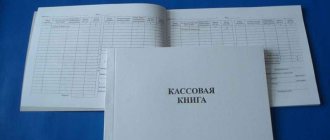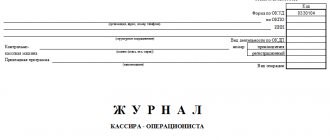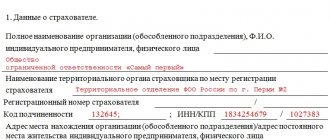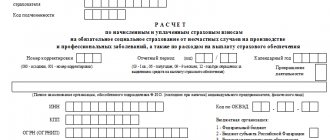Innovations from 2017-2021
According to the explanations of the tax inspectorate (letter of the Federal Tax Service of the Russian Federation dated September 26, 2016 No. ED-4-20 / [email protected] and the Ministry of Finance of the Russian Federation No. 03-01-15/19821 dated April 4, 2017), the transition to online cash registers is made by filling out a cashier’s certificate report -operator optional (all information about ongoing cash register transactions is stored in your personal account on the Federal Tax Service Inspectorate website).
What documents are not needed at online checkout?
According to the letter of the Federal Tax Service of Russia dated September 26, 2016 No. ED-4-20 / [email protected] , 9 unified documents are optional for registration:
- Form No. KM-1 - act on the translation of cash register meter readings.
- Form No. KM-2 - an act on taking readings from KKM control meters when handing over the cash register for repairs and when returning it to the company.
- Form No. KM-3 - act of returning money to the client.
- Form No. KM-4 - journal of the cashier-operator.
- Form No. KM-5 - register of cash registers operating without a cashier-operator.
- Form No. KM-6 - certificate-report.
- Form No. KM-7 - information about cash register meters and the company’s revenue volume.
- Form No. KM-8 - call log for technical specialists.
- Form No. KM-9 - act on checking cash at the cash register.
The following documents are required for online checkout:
- cash book (individual entrepreneurs are kept at will);
- PKO and RKO.
The cash book reflects data on cash inflows and outflows. It records the details of the PKO and RKO, the recipient, and the one who deposits the funds.
Certificate-report of the cashier-operator (form KM-6)
Home / Cash register
| Table of contents: 1. Innovations from 2017-2021 2. Instructions for filling out the KM-6 form 3. No cash transactions | Document: Download the certificate form KM-6 View sample filling KM-6 |
A cashier-operator's certificate-report is a primary document that displays the results of the company's work and is intended to account for the organization's revenue received for a working day (shift).
The certificate-report is drawn up based on the information in the cashier-operator’s journal (KM-4) filled out for a given day (shift) or according to the X- and Z-reports.
The Z-report refers to the report that the cashier takes from the cash register at the end of the shift (working day). It provides data on cash transactions performed. Based on the balance indicated in the Z-report, the cashier checks the cash and transfers it to the administrator.
The X-report refers to the report that the cashier takes from the cash register to determine the amount of cash processed during the day (shift). It can be withdrawn an unlimited number of times at any time, the information will not be displayed anywhere, and the revenue will not be reset.
Indicators contained in the certificate report: data on payments in cash and payment bank cards (non-cash transfers of funds to the company's current account are not taken into account), refunds made to customers.
Storage: since the certificate refers to the primary documents confirming the implementation of cash payments via cash register, the storage period is 5 years.
Innovations from 2017-2021
According to the explanations of the tax inspectorate (letter of the Federal Tax Service of the Russian Federation dated September 26, 2016 No. ED-4-20 / [email protected] and the Ministry of Finance of the Russian Federation No. 03-01-15/19821 dated April 4, 2017), the transition to online cash registers is made by filling out a cashier’s certificate report -operator optional (all information about ongoing cash register transactions is stored in your personal account on the Federal Tax Service Inspectorate website).
Instructions for filling out the KM-6 form
The cashier-operator's certificate-report is filled out daily in a single copy. A legally developed form - form KM-6, approved by Decree of the State Statistics Committee of Russia dated December 25, 1998 No. 132
Cap part
Information about the organization or individual entrepreneur
- Name - must correspond to that specified in the constituent documents (in practice, an abbreviated name is most often used, but only if it is specified in the documentation). An individual entrepreneur indicates his full last name, first name, and patronymic (in accordance with registration documents with the Federal Tax Service).
- Address: as a rule, the legal address is indicated for organizations and the address of residence for individual entrepreneurs; telephone.
- Structural unit (if available)
OKPO code
This is the main code of organizations and individual entrepreneurs in statistical bodies (can be found by TIN on the official website of Rosstat). An empty field will not be a blunder.
OKDP code
OKDP is a classifier of products by type of economic activity. Lost force, OKPD 2 is used instead.
Codes can be determined depending on the type of product: on the websites of the Ministry of Economic Development of the Russian Federation, Rosstat (https://www.gks.ru/metod/classifiers.html) or do not fill in this field.
Cash register
Here you can find information about the cash register model, the manufacturer's number (serial number of the cash register indicated in the documentation) and the registration number indicated in the registration card of the cash register with the Federal Tax Service.
Attention! The list of cash registers approved for use from 2021 is presented on the official website of the tax service (https://www.nalog.ru/rn77/related_activities/registries/reestrkkt/).
Cashier field, etc.
Enter the cashier's last name and initials. If the certificate is compiled in sections with different cashiers, the field may remain empty.
Below is the number and date of the document, working hours
Tabular part
1 column
The number of the Z-report taken for the current day (shift) is entered - displayed on the report itself. This column coincides with column 4 of the cashier-operator’s journal.
2nd and 3rd column
If KKM provides for the division of Z-reports into various departments, these columns display the numbers of departments and sections (optional). If division by department is not provided, then a dash is added.
4 column
The report form is outdated; there is no need to fill out this column (a dash is placed).
5 column
The sum of all punched cash register checks for the entire period of its operation is displayed (cumulative result of activity). In the X- and Z-report, the cumulative total can be displayed with the following names:
- GROSS TOTAL;
- CUMULATIVE SALES TOTAL;
- NI.
Something to keep in mind! The amount can be taken from column 6 of the cashier-operator's journal, the X-report of the current day's cash register or the Z-report of the previous day's cash register.
6th column
Results of activity at the end of the current day (shift): data from the Z-report of the current day or column 9 of the cashier-operator’s journal (cumulative total).
7 column
The revenue received for the shift is displayed (the sum of all punched checks minus any refunds made). The data in the column coincides with column 10 of the cashier-operator's journal.
8 column
The total result of refunds made to customers and erroneously issued checks. The information is displayed in the KM-3 act. All receipts for which the refund was made are attached to the act. The data in the column coincides with column 15 of the KM-4 journal
9th and 10th column
Last name and initials of the head of the department. If there is no position of manager, the full name of the cashier is given. And also the signature of the specified person.
Data after the table
After filling out all the columns of the table, the total amount of revenue received (minus returns) in rubles and kopecks is entered in words.
Based on the completed journal of the cashier-operator, the cashier draws up a certificate-report KM-6, transfers this form to the senior cashier (chief accountant, manager) simultaneously with the proceeds from the cash receipt order (the report includes the PKO number and the date of preparation).
In small companies, a cashier-operator or an individual entrepreneur who combines all positions independently transfers the received proceeds to collectors at the bank. In the certificate-report, a note is made about the transfer of funds (bank account details, date, receipt number).
Reverse side of the report: accepting the cash received for the shift (day) according to the PQS and posting the cash received for the shift (day), the responsible persons sign on the reverse side of the certificate: senior cashier, cashier-operator, company management or individual entrepreneur (if combining positions, the same signature is placed several times) .
The prepared certificate-report of the cashier-operator is the basis for filling out a general statement of cash register counter readings and company revenue (according to the KM-7 form).
No cash transactions
If no cash transactions were carried out during the working day (shift), then a certificate-report of the cashier-operator is not drawn up.
Read in more detail: Certificate-report of cashier-operator
Did you like the article? Share on social media networks:
- Related Posts
- Cash register for individual entrepreneurs and LLCs in 2021
- Sample of filling out the KM-4 form
- Sample of filling out the KM-6 form
- Online cash registers in 2021
- Cashier-operator's journal (form KM-4)
Leave a comment Cancel reply
What is a certificate in the KM-6 form?
The job of a cashier is difficult and responsible. In their work, these specialists are guided by Law No. 54-FZ and Directives of the Central Bank of the Russian Federation No. 3210-U dated March 11, 2014. Cashiers are faced with numerous reports that show cash register movements. Every cashier is faced or has encountered the preparation of the KM-6 form. This is an important document for the cashier, his report on the amounts posted at the cash register.
Initially, the report was compiled only on cash revenue, but with the development of technology and the advent of payments using bank cards, such information also began to be displayed in the certificate report.
The form of the certificate - report was approved by Resolution of the State Statistics Committee No. 132 of December 25, 1998. At the same time, the company can use in its work both a unified form and a report form developed at the enterprise. This possibility is enshrined in the Letter of the Federal Tax Service of the Russian Federation No. ED-4-20 / [email protected] dated September 26, 2016. However, it is worth considering that the report form developed at the enterprise must necessarily contain the key details of the unified document.
Form “Form KM-2”
Source/official document: Resolution of the State Statistics Committee No. 132
Document title: Unified form KM No. 2 Format: .doc Size: 92 kb
Print Preview Bookmark
Save to yourself:
Form KM-2 is a unified act on taking readings from control and summing cash meters when handing over (sending) a cash register for repair and when returning it to the organization. The start of filling out the document occurs at the time the cash register is transferred to the repair shop. Among the members of the commission there must be a representative of the tax authority. Then, after the cash register has been repaired, the meter readings after the repair are entered into the report, also in the presence of a representative of the Federal Tax Service. This is done so that stamped checks for monitoring repairs at the technical service center are not considered enterprise revenue.
Form KM-2 was approved on December 25. 1998, by Decree of the State Statistics Committee No. 132, and each organization that uses cash registers when making payments to customers is required to draw up an act in the KM-2 form for each case of repair or maintenance of cash registers in another organization. This is regulated by Letter of the Ministry of Finance of the Russian Federation No. 104 dated August 30, 1993. Now, after organizations have switched to online cash register equipment according to the new law, filling out forms KM-1 - KM-9 is optional. There are explanations about this in the letter of the Ministry of Finance of the Russian Federation No. 03-01-15/37692 dated June 16, 2021 and other documents. Instead of the KM-2 form, employees of the cash register technical service center can issue a correction check. To do this, you must first draw up a memo or act in any form. Such a document must contain the following information:
- Document Number,
- date of its preparation,
- date and time of breaking the control check,
- the reason why the check was punched.
Based on this document, a correction check is issued. Some entrepreneurs are accustomed to maintaining unified forms of primary accounting documentation for recording trade transactions when using cash register equipment, and continue to fill out the forms approved by Resolution of the State Statistics Committee No. 132 of December 25. 1998, including the KM-2 form. Click on the link below to view the KM-2 form and see a sample of how to fill it out.
Sample form KM-2 (front side)
Sample form KM-2 (reverse side)
Preview
Full screen preview
Is it necessary to lead?
Form KM-6 is an important reporting document for the cashier, which indicates the amount of daily revenue. These report certificates are of great importance when carrying out inspections by supervisory authorities.
Based on them, a complete picture of the completeness of the reflection of the enterprise’s revenue is compiled. Certificates are also required when drawing up a summary report.
The question of whether to fill out a report is ambiguous.
The absence of this form does not entail the application of penalties; in many organizations it is simply not needed; private entrepreneurs, as a rule, do without it.
If the supervisory authorities, when carrying out control activities, discover the absence of a certificate-report, then this fact will be considered an aggravating circumstance.
The director of the company will be in trouble, and he, in turn, will transfer all the blame to the cashier.
In addition to the KM-6 report, the KM-7 form can be drawn up - information about cash register counter readings and revenue must be filled out if the enterprise has two or more cash registers.
Why is the KM-6 form needed?
Certificate form KM-6 is the main reporting document of the cashier. It indicates the revenue received and is handed over to the manager along with the revenue. If the proceeds are given to collectors, then a corresponding note is required in the certificate-report.
In the work of inspection bodies, such certificates play a very important role. It is on their basis that a conclusion is made about the completeness of revenue reflection. In addition, information from the KM-6 certificate is used to fill out a summary report. This report includes data on the status of cash register meters and the income of the enterprise.
Features of the help report
The cashier-operator's certificate-report has several characteristic features:
- the KM-6 form, approved by the State Statistics Committee of the Russian Federation in 1998, is unified;
- errors when filling out, as well as deviations from the generally accepted format, may result in a fine during the work of inspection bodies;
- KM-6 must be filled out daily (or at the end of each shift), and simultaneous filling out of certificates for 2 or more days/shifts is not allowed;
- The document must be submitted simultaneously with the proceeds - either to the chief cashier of the company or to the bank;
- The certificate must be kept for exactly 5 years, after which it loses its value.
Important! Column 4 is filled in only when using outdated cash register equipment. If modern devices have been installed in the organization over the past 12 years, then this section should be left blank.
What to do next with the cashier-operator’s certificate-report
The “Cashier-Operator Certificate Report” is filled out by the cashier, then transferred to the senior cashier, if there is one, then either to the accountant or the general director. If you are an individual entrepreneur and have three or more persons, it should be taken along with the money to the bank. Moreover, you need to fill out the paper daily, along with the cashier-operator’s log. If you did not give it to the bank, the final owner of this happiness is obliged to keep it carefully for 5 years in a row. The obligation to fill out such paper remains questionable. No penalties are provided for its absence, but its absence may serve as an “aggravating circumstance” when attracting an entrepreneur under Article 15.1 of the Code of Administrative Offenses or under Article 120 of the Tax Code.
Only cash payments and payments by bank cards are entered into this form. Cashless payments do not go through the cash register, so non-cash payments in the KM-6 form are not taken into account.
ATTENTION: Continuing this article may take away precious minutes of your life for the sake of absolutely useless information! If you don’t feel sorry for them, the essence of the article is colorfully reflected in the cartoon – look, it’s interesting:
Legend says that after this period, it absorbs enough of the host’s vital juices, and can finally be devoured by the mythical monster Tarkoryub.
The monster Tarkoryub will gladly feast on your certificates, internal statutory documents and other nonsense. But it’s better not to feed him again - he could be an agent from the tax office.
General filling rules
In order to avoid mistakes when entering information into the KM-6 form, you must follow the general rules:
The first line of the report should contain the name, address (legal or actual - it doesn’t matter, the main thing is that it is the same in all reports) and telephone number of the enterprise. If there is a separate division, then its name must also be indicated.
If the KM-6 form is filled out by an individual entrepreneur, then he must indicate all the necessary information in the same order. This is a common mistake - many individual entrepreneurs believe that they can deviate from the unified form, because they work for themselves. The document must indicate the name, registration number and number of the CCP manufacturer. You must indicate the exact date of completion and certificate number. Revenue must be reported in numerical form and in words. The signature of the author of the certificate report is a required element.
How to fill?
To prevent errors when filling out the certificate form, you must follow the general rules. The help report is presented in the form of 3 blocks: line, table and summary.
The first line of the document indicates the name of the company, its address (must be identical in all documentation), and telephone number. The name of the individual unit is also indicated.
For individual entrepreneurs, similar rules apply as for legal entities. In a number of situations, individual entrepreneurs mistakenly assume the use of a similar form, but this report is drawn up only on the approved form.
Below is the TIN of the enterprise, structural unit (if any). In the field intended for entering information about cash register equipment, enter its brand (type, model) and serial number in accordance with the available cash register documentation.
The “Application program” line is not filled in if it is not used in the work. Next, the surname and initials of the cashier are entered in the appropriate line; if there are several cashiers, then the field remains blank.
The “shift” cell records the report number, which, as a rule, begins with the letter “Z”.
The next field contains the document details: number, date, start and completion time of work. Don't forget to fill out this information.
The tabular part of the help report is divided into 10 columns:
- 1 — serial number of the control counter;
- 2, 3 — department and section number, respectively;
- 4 - remains empty when using modern cash registers;
- 5 - readings of the cash counter at the beginning of the shift, day (the amount from column 9 of the cashier’s journal of the last shift, a similar amount is written in the morning X-report, in the GROSS TOTAL line;
- 6 - meter readings at the end of the working day, GROSS TOTAL line of the Z-report;
- 7 - enter the revenue for the shift, the sum of all punched checks, the difference between columns 5 and 6;
- 8 - the amount of all refunds and erroneously issued checks, information is displayed in the KM-3 act, to which all checks confirming the return are attached, the information must match the amount from column 15 of the KM-4 journal;
- 9 - cashier's surname;
- 10 – cashier’s signature.
The total expressions of columns 7 and 8 are recorded in the resulting field.
The cashier generates a Z-report from cash register equipment at the end of the working day (shift). It displays information about all cash transactions. Based on the balance recorded in the Z-report, the cashier reconciles the available cash and then transfers it to the responsible persons, the bank.
The cashier removes the X-report from the cash register to determine the cash in the cash register during the work shift (day). An unlimited number of it can be generated, information about such actions is not displayed, and revenue is not reset.
You can put dashes in the empty lines of the KM-6 certificate so that supervisory authorities do not have questions about the document being unfilled.
In the final block, the amount of revenue is written down in words. The “accepted” line contains the details of the receipt order.
If the report is handed over to the collector, then information about the transfer of proceeds to the bank is entered; when transferring it to the chief cashier, this line is not filled in.
Next, the cashier, senior cashier and head of the company put their signatures; if these positions are combined by one employee, then the signature is affixed three times.
Filling out a line help topic
For the convenience of presenting information, we will reflect the order of filling out this section in the table.
| Help column | How to fill it out |
| Organization | In this column you must write down the name of the company or entrepreneur. The full name must be indicated. In addition, you also need to enter your phone number here. |
| TIN | In this field we indicate the identification number of the organization or entrepreneur |
| Structural subdivision | Not all organizations have such divisions. However, if they exist, then you need to record this information in the report, that is, indicate the structural unit where the revenue was received for the day |
| Information about CCP | In this column we indicate which cash register model is used. Such information is presented both in the documents for the cash register and in the cashier’s journal, on page 1 |
| Cash desk number | This information is usually provided by the senior cashier (it is recorded on page 1 of the cashier's journal). If you cannot obtain information in this way, you will have to look for the cash register number in the documents for it |
| Application program | Application programs are not always used with cash registers. If such programs are not used when using a cash register, then the column is not filled in |
| Cashier | This column is not filled in if there are several cashiers. If there is 1 person working, then you need to write down his last name, first name and patronymic |
| Change | In this column we indicate the number of the Z-report. As a rule, it starts with the letter Z and is written like this: Z00012 |
| IMPORTANT! When drawing up a certificate report, we must indicate its serial number, date, start and end time of preparation |
Filling out the help table section
Here is a breakdown of the columns in the table.
| Help column | How to fill it out |
| Column 4 | As mentioned above, this column is filled out quite rarely, only when using very old cash registers. If the cash register used in the organization was released no earlier than 2004, then the data is not entered in the column |
| Column 5 | Here you need to enter the amount of cash at the beginning of the shift. This data can be taken from the cashier's journal or in the report that was compiled in the morning. We will be interested in the line GROSS - TOTAL |
| Column 6 | In this column we enter data from the Z-report, along the line GROSS - TOTAL |
| Column 7 | This column indicates the total amount from the Z-report, taking into account the refunds made |
| Column 8 | We fill in if there are returns (we take them from Z-reports). We will not fill out this column if there have been no returns. |
| Column 9 | In this field you need to indicate the name of the cashier who is preparing the report |
| Column 10 | The cashier - the preparer of the report puts his signature, thereby certifying that the information contained in it is correct |
| Total line | In this column we reflect the total amount that was obtained based on the results of columns 7 and 8 |
Completing the final help section
Let us show the completion of the third, final part in the table.
| Field value | How to fill it out |
| Total revenue | Here we reflect the amount of revenue received per day. The value of the indicator is written in words |
| The amount that is accepted and entered into the cash register | This field is often left empty, however, if a receipt order is issued, you will have to fill it out. This happens quite rarely in life |
| Amount deposited in the bank | As can be seen from the name of the line, it is filled in only when the proceeds are delivered to the bank or when transferred to a collector. In this case, information about the details of the bank where the proceeds are deposited is entered into the settlement certificate. Otherwise the line remains empty |
| Receipt number | The line with the receipt number is mutually linked with the line about accepting the amount of money at the cash register, so in most cases it is also not filled in |
After filling out all the necessary lines, we write down who is the senior cashier, cashier and head of the company. These persons must sign the report and indicate the transcript of the signature.
Sample of filling out a certificate-report of a cashier-operator (form KM-6)
Here is a sample, KM-6 can be found further down the page.
An example of filling out the KM-6 form
The cashier-operator certificate (form code according to OKUD - 0330106) is filled out by the cashier according to the following scheme:
- In the line “Organization, address, telephone number” the name of the organization is written;
- In the TIN line - accordingly, the TIN of the organization;
- In the line “Cash register” - the model of your cash register;
- In the line “Manufacturer number” - the serial number of the cash register (data for points 3-4 can be found on page 1 of the cashier-operator’s journal);
- In the “Cashier” column, enter your last name and initials (if you are making a report for several sections with different cashiers, you can leave it blank);
- In the “Shift” column, write the number of the current Z-report;
- Write the document number in order - for your convenience it will be better if it coincides with the Z-report number;
- In the general table, enter the Z-report number in column 1;
- In column 2 (department), enter the department number;
- Leave columns 3 and 4 blank;
- In column 5, enter the amount at the beginning of the working day (either from the GROSS TOTAL line of the morning X-report, or from column No. 9 of the last completed line of the cashier-operator’s journal);
- In column 6, write the amount indicated in the GROSS TOTAL line of the Z-report;
- In column 7 - the amount indicated in the line Changeable Total of the Z-report (if there were returns = Changeable Total-Returns);
- In column 8 - the amount indicated in the Refunds line (if there were no returns, leave it blank;
- In column 9, write the cashier's last name;
- In column 10 – signature;
- In the Total column – the sums of lines 7 and 8, respectively;
- Empty columns of the table, if any, can be crossed out;
- In the line “Total revenue in amount” write the amount of revenue for the shift in words;
- The line “Accepted... on a cash receipt order” will be of interest to you if you are a sophisticated clerical maniac and want to write out another one on this useless piece of paper, namely a cash receipt order;
- In the line “Delivered to the bank” - bank details if you give the certificate to the collector;
- "Receipt No".... Oh, and “Receipt No.”? see paragraph 20;
- This is followed by the autographs of the top officials of your company, or the one who acts on their behalf by proxy.
What to do with the KM-6 form after filling it out
The completed document must be given to the chief cashier, if the company has one. The chief cashier passes the certificate report to the general director or accountant. If there is no such cashier, then the cashier-operator gives the document directly to the accountant or director. The certificate must be kept for 5 years.
Important! Individual entrepreneurs, as a rule, are triune. An individual entrepreneur is his own cashier-operator, accountant and manager. Therefore, he gives the document directly to the bank.
Features of using a certificate in the KM-6 form
| Filling conditions | Decoding |
| Who fills out the certificate | Since the preparation of this report is related to the material side of the company’s activities, its preparation should be carried out by the financially responsible person. The cashier is just such a person |
| How information is filled out | All data is entered into the certificate form using a pen with blue or black ink. |
| Are blots allowed when filling out the form? | Since this document is very important and concerns the financial sector, it must be filled out in legible handwriting, preferably without errors or blots. If regulatory authorities find corrections, a fine may be imposed |
| Certificate preparation period | Such certificates are prepared every day |
| Who is the report sent to? | The completed certificate along with the cash is handed over to the senior cashier, accountant or director of the enterprise. It is also given to the bank |
| Certificate storage period | Certificate – the report must be kept by the company for 5 years |
Features of using a certificate in the KM-6 form
| Filling conditions | Decoding |
| Who fills out the certificate | Since the preparation of this report is related to the material side of the company’s activities, its preparation should be carried out by the financially responsible person. The cashier is just such a person |
| How information is filled out | All data is entered into the certificate form using a pen with blue or black ink. |
| Are blots allowed when filling out the form? | Since this document is very important and concerns the financial sector, it must be filled out in legible handwriting, preferably without errors or blots. If regulatory authorities find corrections, a fine may be imposed |
| Certificate preparation period | Such certificates are prepared every day |
| Who is the report sent to? | The completed certificate along with the cash is handed over to the senior cashier, accountant or director of the enterprise. It is also given to the bank |
| Certificate storage period | Certificate – the report must be kept by the company for 5 years |
Is it possible not to fill out the KM-6 form?
This question is ambiguous. On the one hand, no one is fined for the absence of a certificate-report. Many enterprises simply do not require it, and individual entrepreneurs most often do without it. But if the check reveals the absence of such certificates, then this will be considered an “aggravating circumstance.” The manager will have problems, and naturally he will blame the cashier-operator who did not fill out the KM-6 form.
No cash transactions
If no cash transactions were carried out during the working day (shift), then a certificate-report of the cashier-operator is not drawn up.
Procedure for filling out 1-TP
Instructions for filling out and the form can be found in Rosstat Order No. 564 dated August 31, 2017.
1-TP consists of a title page and three sections.
The name of the respondent, legal and postal address with index are noted on the title page. The first sheet already contains the OKUD code; the company just needs to enter its OKPO code.
Section 1
The information in this section is shown as of the end of the year.
All vehicles specified in the section must be capitalized and registered with the traffic police. The type of car is determined by its registration certificate.
Rented and leasing vehicles are not taken into account in this section.
The third column records the number of vehicles, including those under repair, for rent. Technically serviceable cars are shown in column 4. Vehicles that are awaiting repair or are being serviced, cars without tires are not taken into account in column 4.
From the total number of cars, columns 5 and 6 highlight the number of cars equipped with GLONASS and GLONASS/GPS satellite navigation equipment.
Line 100 is the sum of lines 101-107. The indicated lines show dump trucks, cargo vans, tanks, timber trucks and other body structures. Pickup trucks and passenger vans are not included.
Line 108 shows tractor vehicles designed for permanent work with a semi-trailer.
According to lines 109–112 (from line 100), trucks are distinguished depending on the engine design and type of fuel. In line 109 you need to show vehicles running on gasoline, in line 110 - on diesel fuel, and on line 111 - on gas. Line 112 indicates vehicles running on other types of fuel. If you add the data from lines 109–112, you should get the figure indicated in line 100.
According to lines 113-115, vehicles recorded in line 100 are divided into categories depending on the maximum weight of the vehicle (the maximum permissible weight of the equipped vehicle along with cargo). According to GOST, there are three categories:
- Freight transport weighing up to 3.5 tons.
- Freight transport weighing from 3.5 tons to 12 tons.
- Freight transport weighing more than 12 tons.
Line 116 identifies the number of trucks equipped for the transportation of dangerous goods. If the car transports goods to another city or country, it must be shown in line 117.
Line 120 indicates the number of light-duty trucks and utility vehicles with bodies built on passenger car chassis.
Line 130 shows different types of semi-trailers that are connected to tractor units. Also in this line you should take into account spare semi-trailers (tippers, vans, container ships, tanks and others).
On line 131 the number of container semi-trailers is recorded, on line 140 - the number of trailers (flatbed, dump, etc.), on line 150 - the number of special-purpose vehicles.
Section 2
This section is filled out even by those companies for which cargo transportation is not their main activity.
You need to take into account freight vehicles owned, rented, or leased.
Vehicle-days are given in whole numbers, other indicators are given with one decimal place (accurate to 0.1).
Transportation and operating indicators of trucks are reflected in the form by type of movement: city, suburb, intercity and international traffic.
Line 210 shows the days the vehicle is at the company’s disposal separately for each vehicle. Weekends and holidays are taken into account. If the machine worked in several shifts during the day, then this time is considered one vehicle-day.
Lines 220 and 240 show the total volumes of cargo transportation and cargo turnover carried out on public roads.
Transportation of passengers in trucks is not recorded in the report.
The volume of cargo transported on public roads in tons and ton-kilometers is not taken into account:
- when using vehicles not for cargo transportation, but for maintenance of power lines and pipelines;
- when transporting non-commercial goods (snow, household waste, construction waste, etc.);
- when using vehicles for scientific research and geological exploration;
- if the car transports mail, newspapers, magazines.
Freight turnover is equal to the sum of the products of the weight of the cargo for each trip and the transportation distance for each trip.
Example of cargo turnover calculation:
On May 14, 2021, 5 rides were completed:
- first ride: 2 tons over a distance of 16 km;
- second trip: 6 tons over a distance of 25 km;
- third ride: 5 tons over a distance of 9 km;
- fourth ride: 4 tons over a distance of 11 km;
- fifth trip: 13 tons over a distance of 22 km.
Cargo transportation = 2 + 6 + 5 + 4 + 13 = 30 tons.
Cargo turnover = (2 t x 16 km) + (6 t x 25 km) + (5 t x 9 km) + (4 t x 11 km) + (13 t x 22 km) = 557 t.km
Transportation for a fee is separated from lines 220 and 240 and reflected in lines 221 and 241.
In lines 222-234, the transportation of certain types of raw materials and supplies is noted. For example, line 228 records the transportation of cement, and line 231 records grain.
Dangerous goods are also listed as a separate line (line 235). Cargo transported in containers, packages, semi-trailers is recorded in lines 236-238, respectively.
In line 250 you need to show the mileage of vehicles for the year, and in line 251 - the mileage with cargo.
The total mileage can be determined from the odometer; in addition, the daily mileage is reflected in the car's waybill.
Cashier-operator journal for online cash register
The cashier-operator's journal is an optional form of filling out according to the letter of the Federal Tax Service of Russia dated September 26, 2016 No. ED-4-20 / [email protected] Because the data that was previously recorded in the journal is now sent to the Federal Tax Service online.
Why do you need a cashier-operator’s journal and who should have it?
The cashier-operator's journal is needed for the online cash register to take into account the receipt and expenditure of cash. Despite the fact that since July 2017 it is optional, it will be useful for internal accounting.
The log is kept by an employee who serves customers using cash registers. The document is kept by the manager or chief accountant.
If you still decide to conduct it, then read the instructions below.
How and when to fill out the cashier-operator log
Companies and entrepreneurs decide for themselves what rules to use to fill out the journal. But they must definitely follow the template from Resolution No. 132.
The description of the KM-4 register states that the cashier-operator's book is maintained by the cashier every day. The entry is made in the journal using a ballpoint or blue ink pen.
If you are correcting a record, be sure to obtain a visa from your boss or chief accountant.
Until July 1, 2021, maintaining a cashier-operator journal for an online cash register required: firmware, numbering and registration with the tax office. Now registration is not needed, and numbering and lacing is carried out at the request of the individual entrepreneur and organization.
The requirements for maintaining KM-4 oblige the cashier to fill out the journal after removing the Z-report.
Step-by-step algorithm for filling the PKO
Account cash warrant
According to Directive No. 3210-U, an expense cash order is issued when cash is issued from the cash register. You cannot make corrections to a completed form.
Step-by-step algorithm for filling out RKO
Forms No. KM-1 - No. KM-9 are not required for use at online cash registers
From 01/01/2013, the forms of primary accounting documents contained in albums of unified forms of primary accounting documentation are not mandatory for use. From this moment on, primary accounting documents are compiled according to forms approved by the head of the economic entity (Part 4, Article 9 of the Federal Law of December 6, 2011 No. 402-FZ “On Accounting”).
At the same time, forms established by authorized bodies in accordance with and on the basis of other federal laws (for example, cash documents) continue to be mandatory for use. The Russian Ministry of Finance reported this in Information No. PZ-10/2012.
The commented letter from the Federal Tax Service of Russia deals with unified forms of primary accounting documentation for recording cash settlements with the population when carrying out trade operations using cash registers (forms No. KM-1 - No. KM-9), approved by the Decree of the State Statistics Committee of Russia dated December 25, 1998 No. 132 (hereinafter referred to as Resolution No. 132). In 2014, the tax service considered these forms mandatory for use and stated: it is unacceptable for the head of an economic entity to determine forms of accounting documents, the use of which is determined by the legislation on the use of cash registers and is associated, in particular, with the performance by tax authorities of control functions in the field of application of cash registers (letter from the Federal Tax Service of Russia dated June 23, 2014 No. ED-4-2/11941).
However, from July 15, 2016, in connection with the entry into force of the Federal Law of July 3, 2016 No. 290-FZ, economic entities have the right to voluntarily switch to using online cash registers. Such changes were made to the Federal Law of May 22, 2003 No. 54-FZ “On the use of cash register equipment when making cash payments and (or) settlements using payment cards” (hereinafter referred to as Law No. 54-FZ).
Organizations and entrepreneurs have the right:
- submit to the tax authorities an application for registration (re-registration) of the cash register, containing mandatory information;
- enter into an agreement with the fiscal data operator;
- begin transmitting fiscal data to tax authorities in electronic form.
As of February 1, 2017, the use of online cash registers will become mandatory for all economic entities, except for those for which transitional provisions are provided. We talked about this in “NA” No. 17, 2021, on page 73.
In connection with the voluntary transition of economic entities to a new procedure for using cash registers, the tax service clarified its point of view on the use of unified forms No. KM-1 - No. KM-9. Since the legislation of the Russian Federation on the application of CCP consists of Law No. 54-FZ and normative legal acts adopted in accordance with it, and Resolution No. 132 is not a normative legal act adopted in accordance with Law No. 54-FZ, it does not relate to legislation RF on the use of CCP, and, therefore, is not subject to mandatory application.
Common mistakes when filling out
Newbie cashiers sometimes make the ridiculous mistake of entering their own TIN instead of the company’s TIN. Of course this is wrong. The identification number must always belong to the company.
Columns 5 and 6 of the main table should not be confused. Column 5 contains the GROSS TOTAL of the X-report, and column 6 - the GROSS TOTAL of the Z-report. It can't be the other way around. This mistake is often made due to inattention.
Other errors are due to inattention when entering numerical values. For example, you can confuse the date or make a mistake when entering the amount. Such errors are unacceptable, so the cashier should check everything properly.
Important! If there are typos in the KM-6 form itself, then no one will punish the cashier for them. A fine can only be issued for errors in the information that the cashier-operator personally entered.
Where to find a sample of filling KM-1
The KM-1 form is contained in the album of unified forms, approved by Decree of the State Statistics Committee of December 25, 1998 No. 132. You can download it on our website.
Those who needed such a document can see a sample of how to fill it out on our website.
You can find more complete information on the topic in ConsultantPlus. Free trial access to the system for 2 days.
Important points
If the cash register operator's journal is lost, a specialist from the cash register technical service center is called, he takes down a fiscal report (or a report from the EKLZ unit, if the company has a modern cash register with the letter “K”) from the cash register for the entire period from which the journal was lost.
But it would be better to check the dates with the tax inspector; the procedure for restoring the cashier-operator’s journal is not recorded anywhere, each department may present its own requirements.
Then a free form application is written to the tax office about the loss of the cashier-operator’s journal, a power of attorney is issued with a seal for the registration of the cashier-operator’s journal (for the organization), a new journal is purchased and with the fiscal report removed (or with a report from the EKLZ unit).
Then you should contact the Federal Tax Service again (the date the fiscal report was taken), where, based on the documents submitted, they will issue a new cashier-operator journal.
Further actions with the KM-9 act
A sudden check of the cash register can be caused by:
- interest of tax authorities;
- the desire of the company’s management to find out the actual state of accounting and storage of the enterprise’s cash.
| Reason for checking | Number of copies of the act | Locations for document submission |
| Supervisory inspection | three |
|
| Director of the enterprise or chief accountant | two | · Submitted to the management (accounting service) of the enterprise · Stored in the main cash register |
The deadline for submitting the executed KM-9 act depends on the place of submission:
- The document must be submitted to the tax office within three days;
- The management of the enterprise reviews and approves the surprise inspection report immediately after the completion of the procedure.
Let's summarize
- Until July 1, 2021, when working with cash registers, 9 unified documents were mandatory: KM-1 - KM-9. After the introduction of online cash registers, they are no longer needed, because the cash register system sends this data to the Federal Tax Service automatically via the Internet.
- The following are required for registration: cash book, incoming and outgoing cash order.
- Individual entrepreneurs keep a cash book at will, as well as a journal for the cashier-operator. These documents are useful for internal accounting.
- For companies, maintaining a cash book is mandatory, but the cashier-operator's journal is optional.
- Registration of cash receipts or expenditures without orders is prohibited.
Sources
- https://Online-kassa.ru/blog/zhurnal-kassira-operatsionista-i-drugie-dokumenty-pri-onlajn-kasse/
- https://nalog-spravka.ru/spravka-otchyot-kassira-operacionista-km-6.html
- https://nalog.wiki/spravka-otchet-kassira-operacionista/
- https://praktibuh.ru/buhuchet/denezhnye-sredstva/nalichnye/dok/spravka-otchet-kassira-operatsionista-km-6.html
- https://assistentus.ru/forma/km-6-spravka-kassira-operacionista/
- https://blanki.biz/kkt/km-6/








